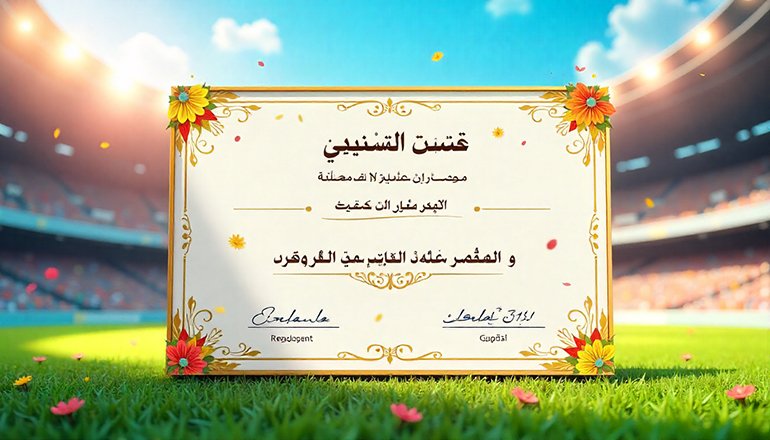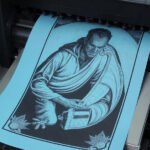
- comelyweb@gmail.com
- Online Printing Services
- September 3, 2025
- No Comments
Creating Stunning Urdu Certificate Designs
Table of Contents
ToggleCraftsmanship: The Art and Spirit of Urdu Certificate Design
Introduction
There is a unique magic to having a certificate. It is more than just a piece of paper. It’s a solid success story, a milestone captured in ink and design. It speaks of a late night study, a perfect recitation of a poem, a winning goal in a tournament, or the successful completion of a course. Now imagine that feeling wrapped in the beautiful, flowing script of Urdu. Urdu certificate is not just a document. It is a work of art that honors the achievement and rich cultural heritage of its recipient.
Designing such a certificate is a very difficult task. It is where calligraphy meets composition, where tradition meets modernity, and where reverence is visually encoded in every element. Whether you’re a teacher, event organizer, business owner, or looking to create a meaningful gift, understanding the nuances of Urdu certificate design allows you to create something that will be cherished for a lifetime. This guide will take you on a journey to create a stunning, respectable, and memorable Urdu certificate.
Deeper Significance: More than just a paper
Before we dive into fonts and borders, it’s important to understand. why These certificates carry so much weight. In many cultures, a certificate is a formal record. But in Urdu-speaking communities, spread across Pakistan, India and the world, presentation is closely related to values of respect.respect(definition)Bandand formal recognition (Sarah)۔
An Urdu certificate often marks important cultural and educational milestones:
- Completion of Qaida and Nazra: Celebrating a child’s first steps in reading the Qur’an.
- Mushairah and Mahfil Milad: Identification of Participants in Poetic Symposia or Religious Gatherings.
- Academic Excellence: Excellence in schools and universities where Urdu is the medium of instruction.
- Cultural Events: Prizes for calligraphy, debate, or sports competitions.
- Corporate Recognition: Employee awards in companies in Urdu speaking areas.
So the design should have a tone of dignity and celebration at the same time. A poorly designed certificate can feel impersonal and cheap, while a thoughtfully designed one elevates the entire experience.
Pillars of Extraordinary Urdu Certificate Design
Creating a beautiful certificate depends on four main pillars: layout and composition, typography, visual elements, and color theory.
1. Structure and Structure: Foundation
Layout is the structure of your design. It holds everything together and guides the viewer’s eye.
- Classification is important: What is the most important piece of information? Usually, this is a title (for example, “Sana-i Imtiaz” – Certificate of Excellence). It should be the largest and most prominent element of the text. This is followed by the name of the recipient, the reason for the award, the issuing authority and finally the date and signature.
- Harmony and Balance: Urdu script, with its natural flow, often lends itself beautifully to a symmetrical, central arrangement. It creates a sense of formality, order, and stability—perfect for an official document. However, for a more contemporary feel, don’t be afraid to experiment with a modern, asymmetrical layout, perhaps for a creative writing award.
- Whitespace is your friend: Don’t fill every inch of paper with text and graphics. Plenty of white space (or negative space) gives the design room to breathe, making it look elegant and preventing it from looking cluttered and overwhelming. It frames the content and enhances readability.
2. The Heart of the Matter: Urdu Type
This is where your certificate really comes to life. The choice of font (typeface) can make or break a design.
- Classical Nasakh: The Horus of Urdu Printing. Nasakh is clear, highly readable and beautiful in its simplicity. This is the safest and most formal choice for body text, details and formal descriptions. You can’t go wrong with Nashik.
- Decorative Nastaliq: This is the star of the show. Nastaliq is the flowing, cursive script that Urdu is famous for. It’s artistic and breathtakingly beautiful, but large blocks of text can be difficult to read. Use italics for the main title, the recipient’s name, and perhaps a short quote. It adds an instant touch of tradition and artistry.
- Modern Fonts: The digital age has given rise to many modern Urdu fonts that blend traditional letterforms with a contemporary sensibility. These may be perfect for younger audiences or for certificates for less formal events.
- Important Technical Tip: Make sure your design software supports Urdu text rendering *Right to Left (RTL)**. Programs such as Adobe InDesign, Illustrator, and modern versions of Microsoft Word and Canva handle RTL well. Always proofread carefully; A mistake in the recipient’s name is the ultimate faux pas.
3. Visual Elements: Ornaments
Visual elements frame your text and add thematic context.
- Borders and Ornaments (Jhalar): Intricate borders are a hallmark of traditional Islamic and Urdu art. You can use patterns with geometric designs (Islam forbids idolatry, making geometry the primary artistic expression), floral motifs (such as paisley or buteh), or the Arabic pattern. These can be subtle, blurred lines or bold, colorful frames, depending on the occasion.
- Seals and Marks: An official seal of the issuing body adds immense authenticity. It can be a digital copy of an actual stamp or a beautifully designed circular mark with signature lines.
- Watermarks and background: A light watermark of a building (eg, school logo, mosque silhouette) or a poetic line in a very light shade can add depth and sophistication to the certificate without detracting from the foreground text.
4. Color Language: Setting Moods
Colors evoke emotions and set the tone.
- Formal and academic: Deep blues, burgundies, forest greens, and off-white or cream paper project authority, confidence, and sleep. The gold foil stamp effect can look incredibly luxurious.
- Celebration and Cultural: Vibrant colors like saffron, turquoise, and magenta are perfect for cultural events, children’s achievements, or festivals like Eid. Keep body text in a readable color, such as black or dark gray, and use it in borders and titles.
- Elegant and minimalist: You can never underestimate the power of black, white and monochromatic colors. White certificate with black motif and title in dark red motif can be absolutely stunning and modern.
From Concept to Creation: A Step-by-Step Guide
Let’s translate these principles into action.
- Define the purpose: Is it for a children’s Quran class or a national level poetry competition? Purpose dictates formality.
- Collect the content: First write all the text in the document. Spell names 100% correctly. Decide on the title, recipient’s name, description, issuer’s name, date, and any references.
- Choose your tool:
- Professional: Adobe InDesign is the industry standard for layout and offers excellent RTL support.
- Intermediate: Adobe Illustrator is best for more graphic-heavy, single-page designs.
- Beginners: Microsoft Word (with Urdu Language Pack) or Google Docs can work for simple certificates. Canva is a great option with a growing number of Urdu-friendly templates and elements (search for “Certificate Templates” and adapt them).
- Set canvas: Choose a standard paper size, such as A4 or letter. Set margins to ensure that no important content is cut off.
- Create a layout: Start with a placeholder for your main title. Then add text boxes for the other elements, playing with hierarchy and spacing.
- Add visuals: Add your own border, stamp, or watermark. Place these elements on separate layers in your design software for easy editing.
- Finalizing and Proofing: This is the most important step. Show the digital proof to a colleague or someone fluent in Urdu. Check alignment, spacing, and especially spelling.
- Print with care: A great design can be ruined by bad printing. Use high-quality, slightly thicker paper (eg, card stock). Consider textured paper like parchment for a classic feel. For truly special certificates, look into foil stamping or embossing services.
Creative ideas and inspiration
Don’t be afraid to think outside the box.
- Bilingual Certificates: For international events or diaspora communities, a bilingual certificate (Urdu and English) is incredibly comprehensive and practical. Place the Urdu text prominently at the top and the English translation at the bottom.
- Thematic Design: For a calligraphy competition, the certificate itself can be a masterpiece of calligraphy. For a science fair, add subtle molecular or planet shapes.
- Digital Certificates (e-Sanad): In our digital world, you can create dynamic Urdu certificates! Use tools like Adobe After Effects to create a video file where the catchy title writes itself beautifully on the screen. These are perfect for emailing remote participants.
Frequently Asked Questions (FAQ)
Question 1: I don’t know Urdu. Can I still design urdu certificate?
A: Absolutely, but collaboration is key. You can handle design, layout, and technical aspects using the principles in this guide. However, you should work with a native Urdu speaker for content input and most importantly, proofreading. Never trust online translators for this important thing.
Q2: What are the best (and free) fonts for Urdu certificate design?
A: Many operating systems come with built-in Urdu support. “Urdu Typesetting” for Windows is a solid script font. Google Fonts also offers free and web-friendly Urdu fonts like “Noto Nashik Arabic” (which supports Urdu characters). Always make sure the font has the full character set you need.
Q3: How can I add Urdu text in software like Photoshop or Canva?
A: First enable Urdu language keyboard on your computer (you can do this in system settings). You can then type directly into the text tool. In Canva, you may need to first type text in a word processor and then copy-paste it into a text box to ensure proper RTL flow.
Q4: My printed certificate looks different from my screen. Text appears blurry. Why?
A: This is usually a font embedding or export problem. When saving your final PDF for printing, make sure you choose high-quality print settings and that fonts are embedded in the file. Always request a proof copy from your printer before doing a full run.
Q5: Where can I find high-quality, copyright-free decorative borders for my design?
A: Websites such as Pixabay, Unsplash and Freepik often have vector illustrations (SVG files) of Islamic patterns and decorative borders that are free for commercial use. Always double check the license. You can also find specific resources for Islamic art vectors.
The result: a lasting impression of thoughtful design
An Urdu certificate is a bridge between an achievement and the passion it deserves. It is a physical embodiment of appreciation and recognition. The effort you put into its design — from choosing a font that honors the language to choosing a color that matches the spirit of the event — conveys a deep level of respect for the recipient and their success.
It lets them know that their hard work has been seen, understood, and is now being celebrated with something worthy of their efforts. In a world focused on the digital and ephemeral, a beautifully designed, physical certificate is a timeless artifact. It is a piece of art that will be hung on walls, stored in treasured folders, and looked back on for years to come, with the pride and joy of the moment it was first received. So, design with intention, design with respect, and most importantly, design with heart.





